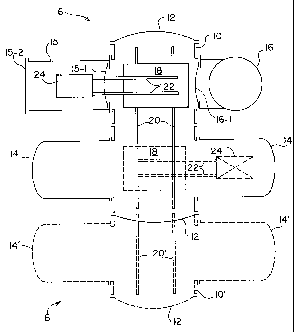Some of the information on this Web page has been provided by external sources. The Government of Canada is not responsible for the accuracy, reliability or currency of the information supplied by external sources. Users wishing to rely upon this information should consult directly with the source of the information. Content provided by external sources is not subject to official languages, privacy and accessibility requirements.
Any discrepancies in the text and image of the Claims and Abstract are due to differing posting times. Text of the Claims and Abstract are posted:
| (12) Patent: | (11) CA 2255343 |
|---|---|
| (54) English Title: | MODULAR VACUUM THERMAL PROCESSING INSTALLATION |
| (54) French Title: | INSTALLATION MODULAIRE DE TRAITEMENT SOUS VIDE THERMIQUE |
| Status: | Expired and beyond the Period of Reversal |
| (51) International Patent Classification (IPC): |
|
|---|---|
| (72) Inventors : |
|
| (73) Owners : |
|
| (71) Applicants : |
|
| (74) Agent: | NORTON ROSE FULBRIGHT CANADA LLP/S.E.N.C.R.L., S.R.L. |
| (74) Associate agent: | |
| (45) Issued: | 2006-10-17 |
| (22) Filed Date: | 1998-12-01 |
| (41) Open to Public Inspection: | 1999-06-02 |
| Examination requested: | 2003-05-23 |
| Availability of licence: | N/A |
| Dedicated to the Public: | N/A |
| (25) Language of filing: | English |
| Patent Cooperation Treaty (PCT): | No |
|---|
| (30) Application Priority Data: | ||||||
|---|---|---|---|---|---|---|
|
The present invention relates to a chained thermal processing installation under rarefied atmosphere including several processing cells linked in a horizontal plane to a common air-tight chamber provided with handling means for transferring a load from one cell to another. The common chamber is a cylinder with a horizontal axis, at least one end of which is arranged to receive a module in the form of a cylindrical extension to which additional cells are connected.
La présente invention concerne une installation de traitement thermique à la chaîne, sous atmosphère raréfiée, comprenant plusieurs cellules de traitement reliées dans un plan horizontal à une enceinte hermétique commune, munie de moyens d'acheminement permettant de transférer une charge d'une cellule à une autre. L'enceinte commune est un cylindre avec un axe horizontal, dont au moins une extrémité peut accueillir un module sous la forme d'une rallonge cylindrique à laquelle des cellules supplémentaires sont connectées.
Note: Claims are shown in the official language in which they were submitted.
Note: Descriptions are shown in the official language in which they were submitted.

2024-08-01:As part of the Next Generation Patents (NGP) transition, the Canadian Patents Database (CPD) now contains a more detailed Event History, which replicates the Event Log of our new back-office solution.
Please note that "Inactive:" events refers to events no longer in use in our new back-office solution.
For a clearer understanding of the status of the application/patent presented on this page, the site Disclaimer , as well as the definitions for Patent , Event History , Maintenance Fee and Payment History should be consulted.
| Description | Date |
|---|---|
| Time Limit for Reversal Expired | 2013-12-03 |
| Letter Sent | 2012-12-03 |
| Inactive: Late MF processed | 2009-01-12 |
| Letter Sent | 2008-12-01 |
| Grant by Issuance | 2006-10-17 |
| Inactive: Cover page published | 2006-10-16 |
| Inactive: Office letter | 2006-09-21 |
| Inactive: Corrective payment - s.78.6 Act | 2006-08-23 |
| Pre-grant | 2006-08-01 |
| Inactive: Final fee received | 2006-08-01 |
| Letter Sent | 2006-05-18 |
| Inactive: Correspondence - Transfer | 2006-03-20 |
| Inactive: IPC from MCD | 2006-03-12 |
| Inactive: IPC from MCD | 2006-03-12 |
| Inactive: IPC from MCD | 2006-03-12 |
| Notice of Allowance is Issued | 2006-02-24 |
| Letter Sent | 2006-02-24 |
| Notice of Allowance is Issued | 2006-02-24 |
| Inactive: Approved for allowance (AFA) | 2005-11-29 |
| Inactive: IPC assigned | 2005-09-07 |
| Inactive: IPC assigned | 2005-09-07 |
| Inactive: IPC assigned | 2005-09-06 |
| Letter Sent | 2003-07-02 |
| Request for Examination Requirements Determined Compliant | 2003-05-23 |
| All Requirements for Examination Determined Compliant | 2003-05-23 |
| Request for Examination Received | 2003-05-23 |
| Inactive: Entity size changed | 2001-12-06 |
| Inactive: Inventor deleted | 1999-10-01 |
| Inactive: Correspondence - Formalities | 1999-10-01 |
| Letter Sent | 1999-10-01 |
| Inactive: Filing certificate - No RFE (English) | 1999-10-01 |
| Inactive: Correspondence - Formalities | 1999-09-30 |
| Inactive: Correspondence - Formalities | 1999-08-31 |
| Inactive: Single transfer | 1999-08-31 |
| Inactive: Cover page published | 1999-06-03 |
| Application Published (Open to Public Inspection) | 1999-06-02 |
| Classification Modified | 1999-01-28 |
| Inactive: First IPC assigned | 1999-01-28 |
| Inactive: IPC assigned | 1999-01-28 |
| Inactive: Courtesy letter - Evidence | 1999-01-19 |
| Inactive: Filing certificate - No RFE (English) | 1999-01-14 |
| Application Received - Regular National | 1999-01-13 |
There is no abandonment history.
The last payment was received on 2005-11-22
Note : If the full payment has not been received on or before the date indicated, a further fee may be required which may be one of the following
Patent fees are adjusted on the 1st of January every year. The amounts above are the current amounts if received by December 31 of the current year.
Please refer to the CIPO
Patent Fees
web page to see all current fee amounts.
Note: Records showing the ownership history in alphabetical order.
| Current Owners on Record |
|---|
| ETUDES ET CONSTRUCTIONS MECANIQUES |
| Past Owners on Record |
|---|
| LAURENT PELISSIER |